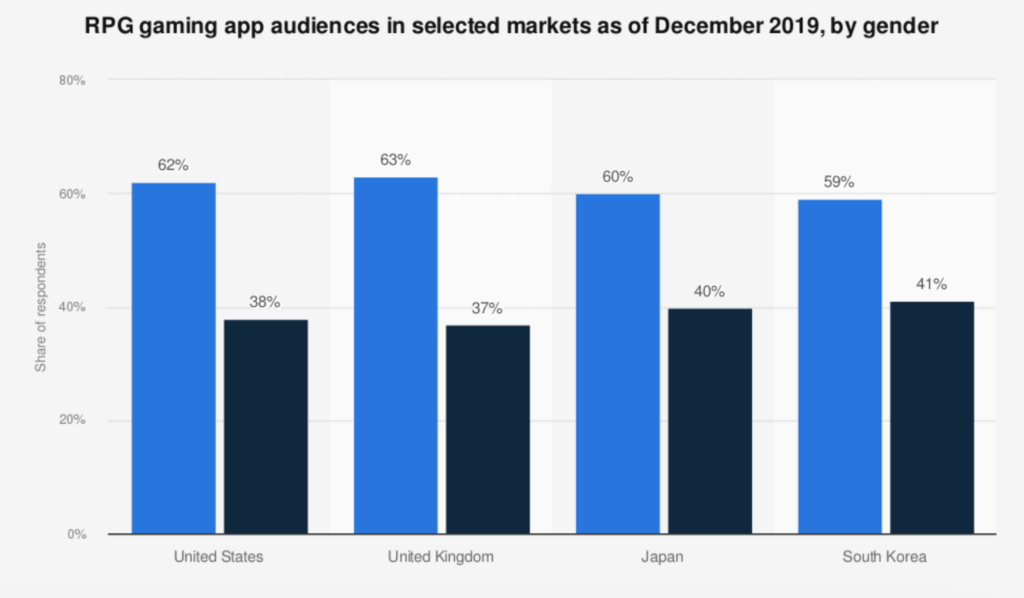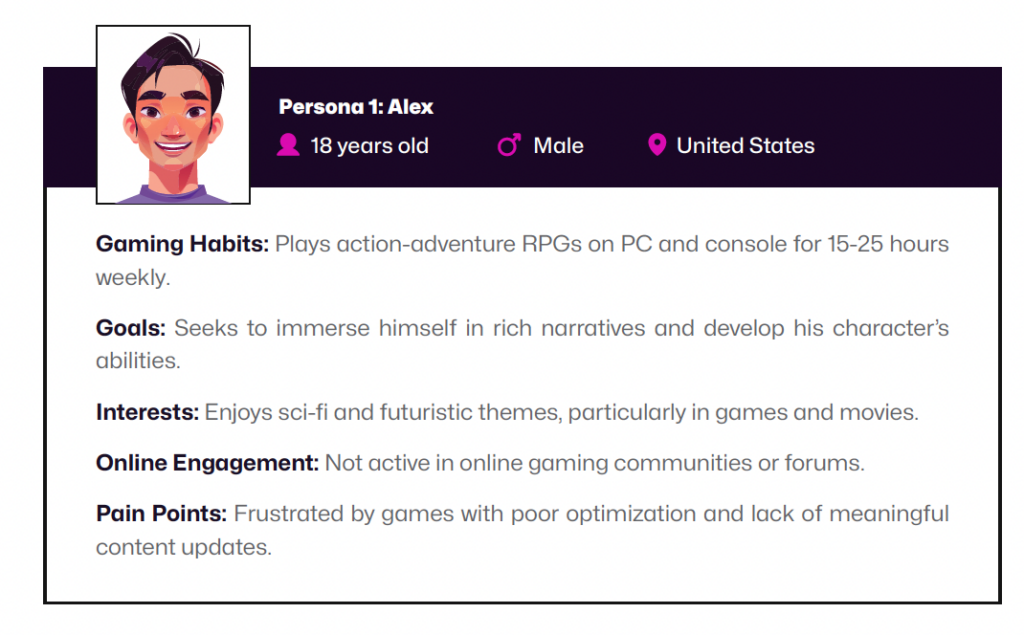How to Define Your Game’s Target Audience with User Personas ?
You’ve probably heard this before: “Build your player base before you launch your game!” Easier said than done, right? Where should you even begin, and how do you make this happen? Crafting your user personas is the key to this problem. With over 3.26 billion gamers expected by the end of 2024, knowing your audience is more important than ever.
However, not all of those gamers have the same taste, therefore your game will not appeal to everyone. You need to focus on gamers who are genuinely excited about your game. Today, we’ll look at how to define your target audience and design user personas that resonate with your game and are more likely to become dedicated players.
Define Your Game Before Defining Your Audience
Before building user personas, you must have a thorough understanding of your game. This is the first phase in the positioning process, laying the groundwork for determining who will be interested in your game.
When defining your game, look for the following info:
- Consider the genre and specificities of your game: What are your game’s genre and mechanics? Is it designed for PC or mobile? Understanding your game’s particularities is key to targeting the right audience.
- Learn from your competition: Research your competitors—both direct (games similar to yours) and indirect (games with related elements and genres, but big differences in either gameplay or specific mechanics). Research what your game has in common with them and define their players’ profiles to get a grasp of your own.
- Identify your game’s strengths: Step into your players’ shoes and think about what will captivate and engage them. Is it the gameplay, the characters, the art style?
The more thoroughly you understand your game’s market, competition, and unique qualities, the easier it will be to define your target audience and connect with the right players.
At GameRebellion, our Game Market Analysis service helps you define your genre, analyze your competition, and identify your game’s unique strengths to ensure you’re targeting the right audience.
Pinpoint the type of players you need
For example, if your game is similar to Call of Duty: Modern Warfare III (2023), your target audience will likely be older, competitive players. These are fans of mature, online multiplayer first-person shooters (FPS) who enjoy intense, fast-paced gameplay.

On the other hand, if your game is more like Banjo-Kazooie (1998), your audience will be broader. This includes younger players and families who enjoy whimsical, story-driven experiences in the action-adventure genre.

By defining these key aspects, you can accurately identify the players drawn to your game. This ensures your marketing efforts resonate with the right audience.
Analyze your target demographics
Analyzing your target demographics is essential to successfully marketing your game and reaching the right players. Start by using tools like review websites, social media analytics, and platforms like Statista to gather demographic information relevant to your game.
These resources provide insights into the typical characteristics of your potential players, helping you understand who they are and what they want.

For example, see this graph on mobile RPG gaming audiences. We can see that in the United Kingdom, 63 percent of mobile RPG gamers were men. In contrast, South Korea had the highest share of female players, with 41 percent of the gaming audience being women.
This allows us to extrapolate that the market for RPG gaming apps is primarily male-dominated, with regional variations that could influence marketing strategies. with that knowledge, we will be able to target the correct market and players!
To further your research, you can look into forums and social media communities to get additional insights. By engaging with these groups, you can directly observe what players are excited about, what they desire in a game, and the challenges they face. And best of all, most of this information is free.
Participating in these discussions not only sharpens your understanding of your audience but also helps you start building relationships with future players.
Segmenting Your Audience
You likely have a rough idea of who your audience might be. At this stage, you’re making educated guesses about their needs and preferences. At Game Rebellion, we begin by segmenting target audiences into Primary and Secondary groups before diving into more detailed segmentation. This approach helps us create a clear, focused strategy right from the start.
The primary audience includes your core players—those most engaged with your game and likely to become loyal fans. This group should be the main focus of your marketing efforts, as they are crucial for building a dedicated community.
The secondary audience consists of those with a more casual interest or who are on the periphery of your core demographic. While they may not be as immediately engaged, they offer significant growth potential. By tailoring your messaging and engagement strategies to these distinct groups, you can better meet their needs and maximize your game’s reach and impact.
Challenge your assumptions about your players
Now, it’s time to challenge those assumptions. You might be convinced that your primary audience is teens, but your research could reveal something quite different.

Take Pokémon, for example. You might assume its primary audience is children and teenagers, given its colourful graphics and accessible gameplay.
However, research shows that most Pokémon players are in their twenties or thirties. These are fans who grew up with the franchise and are drawn to its strategic depth, such as competitive battling and global tournaments. If you only targeted teens, you’d miss the opportunity to connect with this loyal, older audience.
Structure Your Game’s User Personas
You know your game, you know your market, and your audience, now it’s time to organize your players’ types into clear and concise user personas.
A user persona is a simple visual tool which is a fictional representation of your target players —no need for long descriptions or complex character sheets.

A user persona is a snapshot of your ideal player. It captures details like age, gender, gaming preferences, motivations, challenges, and content habits. By understanding who your players are and what they seek, you can fine-tune your game. This makes it more engaging and irresistible to them.
For an accurate user persona, you need to define the following elements:
- Age: Take key ages based on your research
- Gender: Based on the gender distribution of your audience.
- Location: Geographical regions (e.g., North America, Europe, Asia).
- Gaming Habits and Preferences: Assess the frequency of play, preferred game genres, typical playtime, and gamer type (e.g., hardcore, casual).
- Goals: Understand what drives your players—whether it’s completionism, narrative immersion, or other motivations.
- Interests: Explore your players’ gaming-related interests (e.g., social play, farming, competitive gaming) to better cater to their preferences.
- Online Engagement: Analyze how your players engage online—whether they are active on social media, content creators, or more passive consumers.
- Pain Points: Identify challenges your players face (e.g., gameplay difficulty, graphics, mechanics) and how they respond to these issues.
For more information on gaming habits, we have an entire blog article that covers an in-depth analysis of gamer behaviour.
Reaching your Players
We’ve only just scratched the surface of reaching your target audience. With the tools and strategies we’ve seen today, you’re well on your way to identifying your game’s ideal players.
Let’s recap:
- Understand Your Game: Define your game’s genre, mechanics, and unique strengths to set the foundation for identifying your audience.
- Analyze Demographics: Use tools and research to gather demographic data that aligns with your game’s characteristics, helping you pinpoint your ideal players.
- Create and Refine User Personas: Develop detailed user personas to clearly understand your players’ behaviours, motivations, and preferences, guiding your marketing strategy.
By defining your target audience and crafting detailed user personas, you’ll create the first steps of a focused marketing strategy and ensure your game gets the recognition it deserves!
So, what’s next? From identifying your market to analyzing your target audience, we’ve got you covered! You’ve had a sneak peek at what our Game Market Analysis offers with our personalized user-personas profiles, and GameRebellion is here to provide everything you need to craft the most effective game marketing strategy.

